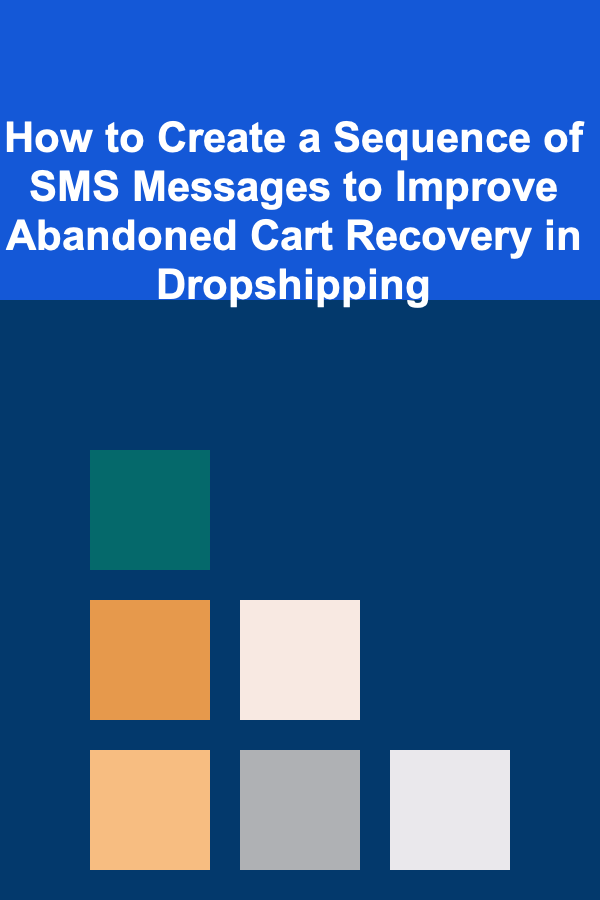
How to Create a Pantry Inventory App for Your Smartphone
ebook include PDF & Audio bundle (Micro Guide)
$12.99$9.99
Limited Time Offer! Order within the next:

In today's fast-paced world, organization and efficiency are paramount, especially when it comes to managing household supplies. One often-overlooked area is the pantry, where having an accurate inventory can save time, reduce food waste, and ensure that you always have the ingredients you need on hand. A pantry inventory app on your smartphone can simplify this process. This comprehensive guide will walk you through the steps of creating a pantry inventory app, discussing everything from planning and design to development and deployment.
Understanding the Importance of a Pantry Inventory App
1. Efficiency in Meal Planning
A pantry inventory app helps users quickly identify available ingredients, which can streamline meal preparation and planning. This efficiency is crucial for busy families and individuals.
2. Minimizing Food Waste
By keeping track of what items are in stock and their expiration dates, users can reduce food waste significantly. An app alerts users when items are nearing their expiry date, prompting timely usage.
3. Improving Grocery Shopping
An inventory app simplifies grocery shopping. Users can generate shopping lists based on what they need, ensuring they only buy necessary items and avoiding duplicates.
4. Enhancing Organization
With a digital inventory, users can categorize and search for items effortlessly. This organization leads to a more functional and tidy pantry.
5. Promoting Healthy Eating Habits
By knowing what healthy ingredients are available, users may be more inclined to cook nutritious meals rather than resorting to takeout or processed foods.
Defining the Scope and Features of Your App
1. Identifying Core Features
Before diving into the technical aspects, it's essential to outline the core features your pantry inventory app will offer. Key features may include:
- Item Entry and Tracking: Allow users to add items along with details like quantity and expiration date.
- Barcode Scanning: Enable users to scan barcodes for quick item entry.
- Search and Filter Options: Provide robust search and filtering capabilities to find items quickly.
- Inventory Alerts: Notify users about low stock levels and upcoming expiration dates.
- Shopping List Generation: Automatically create shopping lists based on current inventory.
- Recipe Suggestions: Generate recipes based on the items in stock.
- User Customization: Allow users to categorize and customize their inventory according to personal preferences.
2. Setting Priorities
Once you've listed potential features, prioritize them. Focus first on the MVP (Minimum Viable Product)---the essential features that will satisfy early adopters.
3. Researching Competitors
Investigate existing pantry inventory apps. Analyze their strengths and weaknesses to identify opportunities for differentiation. Consider user reviews to understand what features resonate with users.
Choosing the Right Technology Stack
1. Platform Selection
Decide whether you want to develop a native app (iOS, Android) or a cross-platform app (React Native, Flutter). Cross-platform development allows for wider reach but may have performance trade-offs.
2. Programming Languages
Select appropriate programming languages based on your platform choice:
- iOS: Swift or Objective-C
- Android: Kotlin or Java
- Cross-Platform: JavaScript (React Native), Dart (Flutter)
3. Backend Development
Choose a backend technology for data storage and retrieval:
- Firebase: A popular choice for real-time database needs.
- Node.js with Express: Ideal for building RESTful APIs.
- Python with Django: A robust framework for scalable applications.
4. Database Management
Select a suitable database to manage your inventory data:
- NoSQL Databases: MongoDB or Firebase Firestore for flexible document-based storage.
- SQL Databases: PostgreSQL or MySQL for structured data relationships.
5. Cloud Hosting Solutions
Consider cloud hosting solutions for deploying your backend services:
- AWS: Offers a comprehensive suite of services for scalability.
- Google Cloud Platform: Provides robust infrastructure for application deployment.
- Heroku: A simpler option for smaller applications.
Designing the User Interface (UI)
1. User-Centric Design Principles
Focus on creating a user-friendly interface that enhances usability. Key principles include:
- Simplicity: Keep the interface clean and uncluttered.
- Consistency: Use consistent color schemes, fonts, and layouts throughout the app.
- Accessibility: Ensure that all users can navigate the app easily, including those with disabilities.
2. Creating Wireframes
Develop wireframes to visualize the layout of your app. Tools like Figma, Sketch, or Adobe XD can help you create these mockups effectively.
3. Prototyping
Once wireframes are ready, create interactive prototypes to simulate user experience. This step allows for early user feedback and iterative improvements.
4. Conducting Usability Testing
Test your designs with real users. Gather feedback on usability and make necessary adjustments before moving on to development.
Developing the App
1. Setting Up Development Environment
Prepare your development environment based on the chosen technology stack. Install relevant IDEs, SDKs, and tools required for development.
2. Implementing Core Features
Start coding the core features outlined in your scope:
- Item Entry and Management: Build forms for adding, editing, and deleting items.
- Barcode Scanning: Integrate libraries such as ZXing or ML Kit for barcode scanning functionalities.
- Notifications: Implement notifications for inventory alerts using local notifications or push notifications.
3. Integrating Backend Services
Connect your frontend app with backend services. Ensure smooth communication between the app and the database for data retrieval and updates.
4. Testing During Development
Perform unit tests during the development phase. Write automated tests to catch bugs early and validate that features work as intended.
Testing and Quality Assurance
1. Functional Testing
Conduct thorough functional testing to ensure each feature works correctly. Test various scenarios, including edge cases.
2. Usability Testing
Gather a group of users to test the app's usability. Observe their interactions and gather feedback for further improvements.
3. Performance Testing
Evaluate your app's performance under different conditions. Ensure it performs well under heavy loads and maintains speed.
4. Bug Fixing
Identify and fix any bugs discovered during testing. Address issues related to functionality, usability, and performance.
Deploying the App
1. Preparing for Launch
Before launching, prepare marketing materials such as a website, promotional graphics, and descriptions for app stores.
2. Setting Up App Store Accounts
Create developer accounts on relevant platforms such as the Apple App Store and Google Play Store. Familiarize yourself with submission guidelines and requirements.
3. Submitting the App
Submit your app for review, ensuring all criteria are met. Monitor the review process and be prepared to respond to any feedback from the review teams.
4. Post-Launch Monitoring
After launch, monitor the app's performance and user feedback. Analyze metrics such as downloads, active users, and crash reports.
Marketing and User Acquisition
1. Social Media Marketing
Utilize social media platforms to promote your app. Share engaging content, tips on pantry organization, and how your app can help users make their lives easier.
2. Content Marketing
Consider creating a blog or video series that shares tips on meal planning, grocery shopping, and reducing food waste. Use this content to drive traffic to your app.
3. App Store Optimization (ASO)
Optimize your app store listings by using relevant keywords, compelling descriptions, and high-quality screenshots. This practice improves visibility and increases downloads.
4. User Engagement
Engage with your users through in-app messages, email newsletters, or social media. Encourage them to provide feedback and reviews to build community around your app.
Maintaining and Updating Your App
1. User Feedback Collection
Continuously collect user feedback through surveys and reviews. Use this information to inform future updates and improvements.
2. Regular Updates
Schedule regular updates to address bugs, improve performance, and add new features based on user requests. Keeping the app fresh and relevant encourages continued engagement.
3. Monitoring Analytics
Utilize analytics tools to monitor user behavior and engagement within the app. Analyze patterns to identify areas for improvement.
4. Community Building
Consider creating a user community---such as forums or social media groups---where users can share tips, recipes, and experiences. This approach fosters loyalty and keeps users engaged.
Conclusion
Creating a pantry inventory app for smartphones is a rewarding venture that not only benefits users by helping them manage their pantry efficiently but also presents numerous opportunities for developers. By following the steps outlined in this guide, you can develop a user-friendly, functional app that meets the needs of a broad audience.
From the planning stage to deployment and maintenance, attention to detail and a focus on user experience will be key to your app's success. Embrace the journey, stay adaptable, and continually seek ways to enhance your app based on user feedback and technological advancements. With dedication and creativity, your pantry inventory app can become an invaluable resource for households everywhere.

How to Create a Checklist for Decluttering Your Entryway: An Actionable Guide
Read More
How to Create a Sequence of SMS Messages to Improve Abandoned Cart Recovery in Dropshipping
Read More
How To Launch a Podcasting Service for Businesses
Read More
How to Summarize Texts in Your Target Language
Read More
How to Master AutoCAD for Mechanical Drafting
Read More10 Tips for Tracking Progress with Your Project Management Planner
Read MoreOther Products

How to Create a Checklist for Decluttering Your Entryway: An Actionable Guide
Read More
How to Create a Sequence of SMS Messages to Improve Abandoned Cart Recovery in Dropshipping
Read More
How To Launch a Podcasting Service for Businesses
Read More
How to Summarize Texts in Your Target Language
Read More